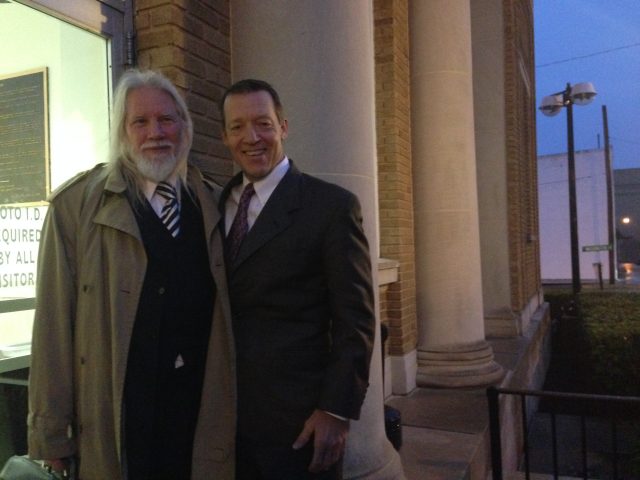
MARSHALL, TX—Newegg's courtroom face-off with patent-licensing giant TQP Development is nearing its end. TQP has sued hundreds of companies, saying it has patented the common Web encryption scheme of combining SSL with the RC4 cipher. Almost 140 companies have paid TQP a total of more than $45 million. But online retailer Newegg, which has sworn not to settle with "patent trolls" like TQP, took the case to a jury.
On Thursday, Newegg's top lawyer, Lee Cheng, took the stand. He was followed by a non-infringement expert and three well-known computer scientists who emphasized the importance of Newegg's "prior art."
Ron Rivest testified, via videotaped deposition, about how he invented the RC4 cipher while at RSA Security in 1987, two years before the TQP patent application was filed. Former Microsoft CTO Ray Ozzie described demonstrating Lotus Notes to Bill Gates in 1988. Alan Eldridge, who worked on the Notes product, flew down to Marshall in person to describe how he put RC4 in the software.
Eldridge wasn't paid, as expert witnesses were—he came down to testify against the Jones patent out of a feeling of "civic responsibility," he said. He didn't know who the defendants in this case were until he was told. "I hadn't even heard of New Age until Saturday," said Eldridge at one point, as laughs were stifled in the courtroom.
On Friday Newegg's star witness, cryptographer Whitfield Diffie, took the stand. Diffie's goal was to knock out the Jones patent with "clear and convincing" evidence (which is the standard for invalidating a patent).
Diffie looked the part of the eccentric genius, resplendent with his long white hair and beard. He spoke with a booming voice but carefully articulated manner; he was professorial but not overbearing. He could have been the amiable professor you wished you'd had in college.
TQP's patent, invented alongside Michael Jones' failed modem business, wasn't much of an invention at all according to Diffie's telling. It was a pre-Internet patent, describing an old method of encoding data. Internet security needed "public key" cryptography.
"We've heard a good bit in this courtroom about public key encryption," said Albright. "Are you familiar with that?"
"Yes, I am," said Diffie, in what surely qualified as the biggest understatement of the trial.
"And how is it that you're familiar with public key encryption?"
"I invented it."
A brief history of public-key crypto
In 1973, Diffie left his work at Stanford's Artificial Intelligence Lab to travel the country and learn more about cryptography.
"It was kind of a secret field at the time, and the literature was hard to find," said Diffie. "I was traveling around academic libraries digging up whatever I could."
The following year, he returned to Stanford and started his work with a professor there, Martin Hellman.
"I want you to put it in perspective for the court and for the jury," said Albright. "What is the problem that you two gentlemen saw that you were so worried about?"
The problem was vast, Diffie explained—nothing less than how to keep things private in a networked world. He recalled a conversation with his wife in 1973, sitting on a New Jersey park bench. "I told her that we were headed into a world where people would have important, intimate, long-term relationships with people they had never met face to face," he said. "I was worried about privacy in that world, and that's why I was working on cryptography."
At that time, the only encryption happened within "closed systems." IBM could encrypt information within its own company's networks, and Texas Instruments could encrypt on theirs. But some kind of courier would have to carry encryption "keys" to both companies before they could do so.
That was the "key distribution" problem Diffie strove to solve. "It's arranging to provide keys to two people who have never met before, who suddenly find themselves with a need to communicate," he explained. "This is much the way we visit websites these days."
There was one other big need: proving authenticity.
"The receiver of the document can come into court with the signed document and prove to a judge that the document is legitimate," he said. "That person can recognize the signature but could not have created the signature."
In spring of 1975, Diffie was "playing house husband" near Stanford, while his wife worked in San Francisco for British Petroleum. It was then, spending his afternoons unbothered working on cryptography, when he hit on a solution that could solve both the key distribution and authenticity puzzles. Public-key crypto could kill two birds with one stone.
"What I suddenly understood was that you could break the key into two pieces, and only one piece would have to be secret," said Diffie, speaking excitedly. "There would be a secret piece and a public piece."
In 1976, he published "New Directions in Cryptography" with Martin Hellman. The paper's cover sheet was displayed on the screen in court.
"Is it fair to say that the jury is looking at a little bit of history, in terms of cryptography?" asked Albright.
"You embarrass me," said Diffie. "But yes, I think it's fair."
The world of cryptography was utterly changed. Whereas there were "not more than a dozen or two" people working on cryptography outside government, "now there are thousands," Diffie explained.
Jones and Erich Spangenberg, the patent-licensing kingpin who owns TQP, have claimed that the Jones patent is fundamental to Internet commerce. They've sued hundreds of companies for infringing it.
Albright made sure the jury got one point clearly: it was Diffie's invention that ushered in the world of online commerce. "Would it be fair to say we wouldn't have Internet commerce without this?" asked Albright.
"I think where there's commerce, it will find a way," said Diffie. "But this has certainly smoothed that way a good deal."
reader comments
134